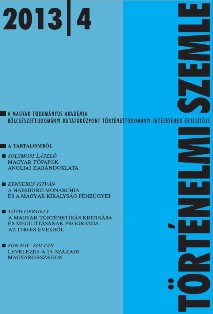A maszk és a jelmez szerepe a kora újkori Magyarországon
The Role of the Mask and the Costume in Early Modern Hungary
Author(s): Péter SzabóSubject(s): History
Published by: Magyar Tudományos Akadémia Bölcsészettudományi Kutatóközpont Történettudományi Intézet
Summary/Abstract: Masks and costumes were needed to represent power. The elementary forms of this developed in the antiquity, when Roman emperors ordered the preparation of their wax masks upon their death to leave them to the posterity. During the High Middle Ages, the legal doctrine emerged in England, stating that the king has two bodies: the body natural and the body politic. In the royal court, a wooden puppet with a wax mask and purple clothes were made to represent the latter. This symbol of eternal kingship, the effi gy, played an important role in the royal funerals. As a result, knights appeared who portrayed the king in flesh and blood in various clothes, for example in the funerals of the Anjou kings. Masks were widely used by nobles, citizens, peasants in the High Middle Ages, during the processions of significant religious festivals. The secular use of masks spread during the human-centered Renaissance, and after the crisis of Renaissance, during the Manierism. The custom of the Italian bourgeoisie was to put death masks on the fireplaces. In the England of Henry VIII, the masquerade was part of the aristocracy’s subculture. The most important occasion of the popular representation was the carnival; with the help of various costumes they could criticize the supreme power. The interest in geographical discoveries and exoticism gave new momentum to the masquerades in European ceremonial culture. The costume of the „savage” became very popular in the festivals of the European ruling class. The connection between Manierism and the mask was obvious. The man fleeing from the crisis of the Renaissance became vulnerable and often chose to hide behind a mask. Archduke Rudolph’s (later Emperor Rudolph II and King of Hungary) ceremonies of Vienna and Prague characterised by mythology and cosmogony, heavily influencing the festivities of the Hungarian Kingdom. The recently arranged documents of the Zeremoniall protokolle 1652–1918 held in the Österreichisches Staatsarchiv gives insight into the ceremonies of the baroque court of Vienna. These unrestrained, splendid events can be justly considered as baroque pieces of art. The balls at the court became the venues of representing national character, as the interest in ethnic characteristics played a crucial role. This study defines the art charachertistics of the procession-like festivities based ont he works of Johann Wolfgang Goethe: 1. Mass number (specifying the ratio). 2. Increasing the splendour: ranking the participants. 3. Increasing the splendour: more and more luxurious clothing (masks). 4. Increasing the splendour: increasingly luxuriant company for the dignitaries. 5. Body acting. We have sources concerning the masquerades and carnivals in the countryside. Concerning these festivities, the first task is to outline the social hierarchy.
Journal: Történelmi Szemle
- Issue Year: 2013
- Issue No: 04
- Page Range: 569-592
- Page Count: 24
- Language: Hungarian

